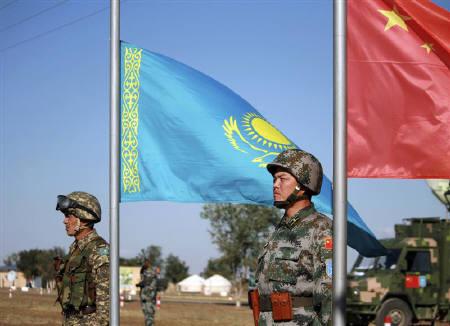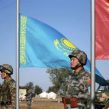
Kazakhstan-China Military Exchanges Continue
Publication: Eurasia Daily Monitor Volume: 9 Issue: 206
By:

Earlier this month, a delegation from the Chinese National Defense University made an official visit to Kazakhstan, marking yet another high-profile exchange between the two countries’ defense establishments. According to Major General Yedil Urazov, the head of the military education and science department in Kazakhstan’s ministry of defense, China is one of Kazakhstan’s “priority” defense partners. The ministry calculates that more than one hundred members of the Kazakhstani armed forces have received education and training in Chinese military academic institutions since 2003 (Kazakhstani Ministry of Defense, November 2).
The Kazakhstani and Chinese armed forces started such defense exchanges in 1993, soon after Kazakhstan became an independent country (Xinhua, September 9, 2004). Initial cooperation also focused on reducing the military forces deployed along their joint border, which had been built up in previous decades during the Sino-Soviet confrontation of the Cold War. The newly independent government of Kazakhstan joined China’s other new Central Asian neighbors in signing several demilitarization and military confidence-building measures. Since 2002, the military and other security forces of Kazakhstan and China have engaged in some two dozen bilateral and multilateral military exercises (see China Brief, March 5, 2010).
Many joint Chinese-Kazakhstani security activities have focused on nontraditional threats such as terrorism, drug trafficking, humanitarian crises and border security. When they met in Beijing in June 2012, Kazakhstan’s President Nursultan Nazarbayev and Chinese President Hu Jintao declared their intent to intensify cooperation against the “three evil forces” of terrorism, separatism and religious extremism (Xinhua, June 6). They also pledged to “jointly uphold a new security concept featuring mutual trust, mutual benefit, equality and coordination, and create a favorable external environment for the development of the two countries” (Chinese Foreign Ministry, June 6).
At their June 2012 summit, the two governments signed a joint declaration to counter these three evil forces, which have been a long-time focal point of their bilateral security cooperation (Tengri News, June 5). For example, the 2009 joint communique, issued after Nazarbayev and Hu met in Beijing in April 2009, mentioned the same commitments and also cited Afghanistan, narcotics trafficking and transnational organized criminal activities as other areas of joint security concern and cooperation (Chinese Foreign Ministry, April 17, 2009). Security cooperation regarding Afghanistan should increase as NATO withdraws its combat forces from that country, requiring Kazakhstan, China and other nearby countries to confront Afghanistan’s security problems more directly.
China has developed some more traditional defense ties with Kazakhstan, but their main interaction occurs in the domains of economics and energy. These exchanges can have indirect security benefits, such as by generating revenue that governments can use to support their security forces. Additionally they can reduce potential sources of alienation and regional extremism by raising living standards in Central Asia and the neighboring Chinese region of Xinjiang, which has a large Muslim population with some violently anti-Beijing-oriented groups. Conversely, widespread socioeconomic problems in Central Asia that contributed to mass social disorders could create state failure and a security vacuum on China’s western frontier as well as facilitate the importation of such disorders into China.
Major obstacles have impeded more traditional defense cooperation between China and Kazakhstan and the other Central Asian countries. These include different military histories, the low priority the parties attach to their military relationship compared with other areas of cooperation, the absence of Chinese military bases in Central Asia, severe language barriers, and Central Asian concerns about Beijing’s long-term ambitions to exercise increasing control over their region as well as, for now, Beijing’s deference to Moscow’s military and broader security primacy in Central Asia.
Most of the more explicit security cooperation that does occur focuses on counter-terrorism rather than conventional military operations. The most prominent of these activities are the bilateral and multilateral counter-terrorism exercises that occur both within and sometimes outside the framework of the Shanghai Cooperation Organization (SCO), though the SCO explicitly disclaims any military ambitions. Other multilateral security cooperation occurs through the United Nations and the Conference on Interaction and Confidence Building Measures in Asia (CICA), a Kazakhstani initiative that China joined as a founding member (China Daily, March 9).
China also provides non-lethal defense equipment to Kazakhstan and the other Central Asian countries, such as uniforms, jeeps and other vehicles, communications systems, and information technologies. But Russia remains the main supplier of advanced weapons systems. Military academic exchanges and other interactions are impeded by the limited knowledge of Chinese by Central Asian officers or Central Asian languages by Chinese military instructors. They must use Russian or speak through interpreters. Kazakhstan’s hopes of receiving decommissioned weapons from the rapidly modernizing People’s Liberation Army (see China Brief, November 7, 2008) have been thwarted by Beijing’s refusal to challenge Russia’s jealously guarded role as the primary supplier of advanced defense equipment to the Central Asian militaries.
In terms of developing multinational defense ties with Kazakhstan and the other Central Asian countries, Beijing’s main challenge is that the Collective Security Treaty Organization (CSTO), which includes Kazakhstan but not China, is by far the dominant regional security institution in Central Asia. Unlike the SCO, the CSTO is a genuine mutual defense alliance whose main activities focus on traditional defense cooperation, including many large-scale military exercises and the sale and joint production of major weapons systems. Even most regional counter-drug collaboration is still led by the CSTO, which conducts an annual “Kanal” series of counter-narcotics operations aimed at interdicting regional drug flows.
In contrast to their modest engagements with China, the Kazakhstani armed forces have much broader and deeper ties with Russia. The two defense establishments share doctrine, weapons and training. Hundreds of Kazakhstani officers regularly enroll in Russian military academies. The two countries also provide the most forces to the CSTO’s collective military units. As a CSTO member, Kazakhstan is eligible to purchase some Russian military equipment at wholesale prices. Russia and Kazakhstan have joint air defense and other partnered units and missions (see EDM, September 28, 2011).
Astana currently holds the CSTO’s one-year rotating chairmanship this year. Kazakhstan makes the largest military contribution to the CSTO after Russia, and the two countries have become the main drivers of recent efforts to strengthen that organization by giving it new missions and capabilities. Its 2007 and 2011 military doctrines stress the organization’s value in promoting Central Asian security. Kazakhstani representatives have supported the expansion of the CSTO’s responsibilities beyond traditional collective defense missions as well as efforts to develop ties between the CSTO and other international institutions, including NATO (Gazeta.kz, June 1, 2011).
For now, Astana sees Russia and the CSTO, rather than China and the SCO, as its main defense partners.




